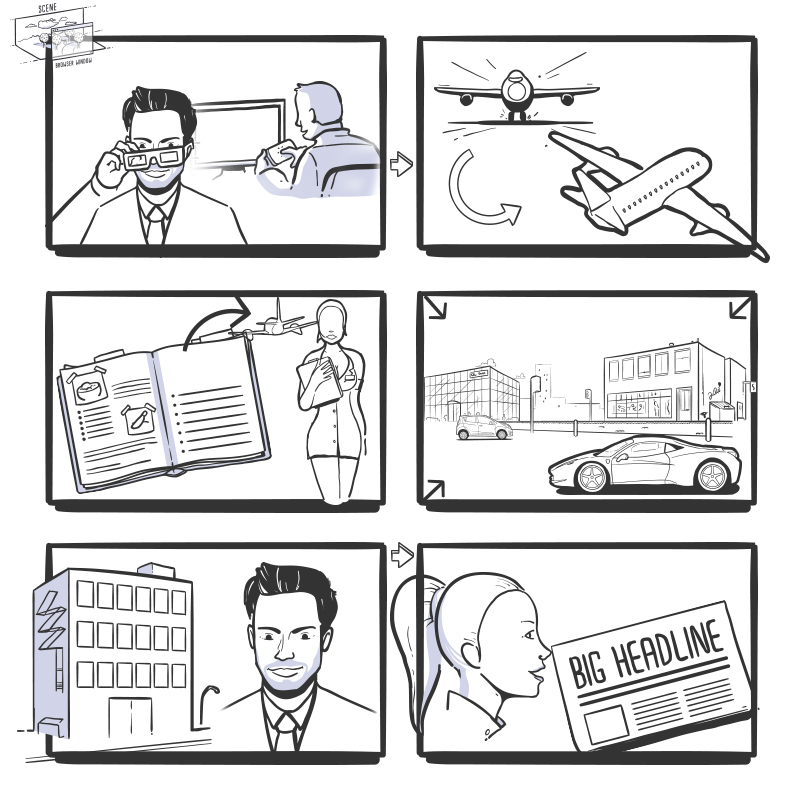Main steps of Explainer / Animation Video Makng Process
If you haven’t heard about the benefits of animated videos, you’re in for a treat. Animated videos, such as video explainers and whiteboard animations, are an excellent way to easily and simply communicate your company’s message, even if your product or service is complex and difficult to understand at first glance. With animation, you can let your imagination run wild and find the best way to attract and convert viewers! If you’re thinking about creating an animated video, it’s important to be aware of the necessary steps involved in animation video making process. In this article, we’ll tell you everything you need to know about working with a professional video company, to produce an animated video.
1. Define the need
Before you even start creating an explainer video, it’s important to set a goal. What do you want the video to achieve? What response do you want from your audience? Having a specific goal in mind will help you focus your efforts and ensure that your video is effective. Some possible goals for an explainer video include increasing brand awareness, generating leads, or explaining a complex concept in a way that’s easy to understand. Figure out what you want your video to achieve, and then craft a message that will achieve that goal.

2. Research and Study
Creating an animated video can be a complex process, and it’s important to do your research before you start. To create an effective video you need to understand the market dynamics, competitor offerings, and USPs of your product or service. You need to understand the market dynamics and what your competitors are offering. How can you differentiate yourself from them? Only by understanding the market landscape will you be able to create a video that stands out and achieves its desired results. One also needs to have a clear idea of the approach to take with the video. By doing research, the studio can develop a video strategy that effectively communicates your message and achieves your desired results. At Clapstick Media, we believe in doing our research before starting any project. We take the time to understand our clients’ businesses inside and out, so that we can develop videos that truly reflect their unique selling points and appeal to their target audience.
3. Set the video style
When it comes to choosing a style of animation for your video, there are a few factors to take into account. The first is your target audience. Some styles of animation are more suited to certain audiences than others. For example, if you’re targeting adults, you may want to choose a more sophisticated style of animation, whereas if you’re targeting children, you may want to go for a more cartoonish look. The second factor to consider is the tone of your video. What type of mood do you want to create? Do you want the video to be light and fun, or more serious and professional? Again, this will depend on your target audience and the overall message you want to communicate. The third factor is your budget. Some styles of animation are more expensive than others. So, before you settle on a particular style, make sure you have a realistic idea of how much you can afford to spend.
Some of the most popular styles include 2D animation, 2.5D / Isometric, 3D animation, motion graphics & white board animation. When selecting a style for your video, it’s important to think about what will be most effective in delivering your message. This is one of the most crucial steps of the animation video making process.
If you want to cut the chase and get started with a great video, we can help! We offer a variety of different styles of animation so that we can find the perfect one for each individual client. We take into account their target audience, tone, and budget when making our recommendations. So, whether you’re looking for something sophisticated and professional or fun and whimsical, feel free to contact our team!

4. Script is super important
The script is one of the most important aspects of any animated video. It’s the backbone of the video, and everything else – the animation, the voiceover, the music – is built around it. If the script isn’t strong, then the video won’t be effective.
That’s why it’s so important to take your time when writing the script. Make sure you understand the message you want to communicate and craft a script that will effectively deliver that message. The tone of the video should be consistent with the tone of your brand, and the visuals should be in line with your target audience. It should also be tailored to your target audience, and take into account the tone and style of animation you’ve chosen. That’s why it’s suggested to leave scripting to the professionals. Even a small flaw in the script baloons up to a massive glitch when the video is created. The studio you hire should work hand in hand with you to develop the script while constanly looping in on your feedback.
5. Storyboard and the role it serves in the video production pipeline
Storyboards are an important part of the video production process. They help to map out the entire video and ensure that everything flows smoothly from beginning to end. They also help to ensure that all the elements of the video – the animation, the voiceover, the music – are working together to deliver the desired message. A good storyboard should be detailed and precise, and it should clearly illustrate how each scene will look and what will happen in each scene. This allows you to get a clear idea of what you’re looking for and makes it easier for the studio to create a video that meets your expectations.
Style frames and art direction are two important aspects of animation that often go overlooked. Art direction is the overall look and feel of the animation. It includes things like the colour palette, the type of fonts used, and the overall aesthetic. Professional illustration / 3D artists work to bring the art direction to life in the storyboard itself. That way you get a concise document outlining the major scenes in the video along with the branding, look and feel of the final output.


6. Voice Over – The voice which binds your viewers to the screen
Voice over is one of the most important elements of an animated video. It can be used to add humor, depth, or emotion to the video, or simply to deliver the message more engagingly. The right voice over can make a huge difference in the overall quality of the video. That’s why it’s important for you to choose a voice over artist who is a good fit for your video. They need to be able to convey the correct tone, and accent and convey the message in a way that engages the audience. Majorly overlooked, this is a very important step of the animation video making process.
At Clapstick Media, we hold a full-fledged audition for our clients. You get to choose the best fitting artist from one of the largest pools of professional voice artists across the globe. This unique ability lets our clients enjoy an unparalleled service otherwise only prevalent in full-fledged cinematic productions.
7. Asset Development – Illustration, Modelling, Material
Once the script & voice over is finalized, the next step is to start developing the assets that will be used in the video. This includes everything from the illustrations to the 3D models to the textures. It’s important to make sure that all of these elements are consistent with each other and with the overall tone and style of the video.
The illustration process begins with creating rough sketches of each scene. These sketches are then refined until they are suitable for use in the video. The same process is followed for 3D modeling, except 3D models are created using software instead of sketches. Texturing is involved in both illustration and 3D modeling, and it involves adding colour and detail to the illustrations or models. Lighting is also important for both illustration and 3D modeling, and it helps to create a desired mood or atmosphere in the video.


8. Animation – The illusion of life!
Animators are artists who breathe life into inanimate objects. They take the illustrations, 3D models & other assets created in the previous steps and turn them into moving images that can convey a message or story. The animation process is complex and requires a great deal of skill and patience. Animators must have a good understanding of movement, VFX and anatomy, as well as the ability to create realistic-looking characters and scenes. They must also be able to work with different software programs and understand the principles of motion graphics. This is naturally the most complex and the longest time taking step of the entire animated video production process.
At Clapstick Media, we have a team of skilled animators who are capable of handling any type of animation project. Their attention to detail and passion for their work ensures that each video is of the highest quality and meets the client’s expectations. We understand the importance of quality animation, and we work hard to ensure that our clients are always happy with the final product.
9. Music and Sound Effects – Crème of the animation video making process
Music is another essential element of an animated video. It helps to set the tone and create an emotional connection with the viewer. It can also help to reinforce the message of the video. Sound effects are an important part of an animation video. They help to create a realistic and engaging experience for the viewer. They can also be used to convey emotions and add humor to the video. We understand the importance of sound effects in an animation video, and we work hard to make sure that our clients are always happy with the final product.
While working with us at Clapstick Media, you need not worry a bit about these. Our specialized compositing teams handle each project at the finishing table before sending for the final render. The result is an elegantly crafted crisp video that is perfectly honed to custom serve our client’s needs.
10. Optional Social Media formats, cuts and promos !
No animated video production process is complete without touching multi-format scenarios. It’s important to make portions or versions of your explainer video in multiple formats like vertical and square.Vertical and square video formats are becoming increasingly popular for social media promotion. This is because they take up less space on the screen, and viewers are more likely to watch them all the way through. Vertical videos are especially effective for mobile devices, as they fit naturally into the vertical screen orientation. Square videos are also a good option for social media, as they occupy a similar amount of space as traditional rectangular videos.
Clapstick Media’s animation process pipeline
Now that you know the animation video making process, let’s focus on how to create an explainer / animation video. The fact is the basic pipeline remains the same across most of the top companies in the market. But what differentiates us is our ability to handle the most demanding steps without draining out the budget. Cause every dime matter and ultimately will higher your bar for ROI.
Our project managers communicate with flawless fluid communication and we don’t shy to disturb you! Multiple calls, meetings, and emails ensure that every detail of your needs is carefully noted and taken into consideration. We don’t do template videos! Simple. Each and every one of our videos is fully tailor-made for your exact needs. It’s not a fluke that top MNCs, Governments across the globe, internationally acclaimed universities, and startups alike hire us for creating their videos.
Our unparalleled attention to detail and unique way of delivering the message without the clutter of unnecessary animations make us the go-to choice when it comes to animation videos.
Have a look at our portfolio to see it yourself.
If you like to learn more about animation in itself please have aread





